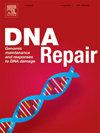BRCA1和BRCA2在DNA损伤和复制应激反应中的作用、机制及其对癌症治疗的影响
IF 2.7
3区 生物学
Q2 GENETICS & HEREDITY
引用次数: 0
摘要
基因组稳定性是细胞存活和增殖的基石。为了对抗内源性和外源性DNA损伤剂带来的持续威胁,细胞依靠复杂的机制网络来保护DNA的完整性并确保准确的复制。其中,BRCA1和BRCA2肿瘤抑制蛋白起着举足轻重的作用。虽然传统上认为它们参与同源重组修复和细胞周期检查点,但新出现的证据强调了它们在复制应激期间保护停滞复制分叉的基本功能。BRCA1或BRCA2的突变破坏了这些关键功能,导致基因组稳定性受损,并增加了对各种癌症的易感性,特别是乳腺癌和卵巢癌。这篇综述全面分析了BRCA1和BRCA2的多方面作用,重点关注它们对DNA损伤反应和复制应激管理的贡献。通过阐明BRCA1和BRCA2运作的分子途径,我们旨在深入了解它们在维持基因组完整性方面的关键作用及其对癌症治疗的影响。本文章由计算机程序翻译,如有差异,请以英文原文为准。
BRCA1 and BRCA2 in DNA damage and replication stress response: Insights into their functions, mechanisms, and implications for cancer treatment
Genomic stability is a cornerstone of cellular survival and proliferation. To counter the constant threat posed by endogenous and exogenous DNA-damaging agents, cells rely on a network of intricate mechanisms to safeguard DNA integrity and ensure accurate replication. Among these, the BRCA1 and BRCA2 tumor suppressor proteins play pivotal roles. While traditionally recognized for their involvement in homologous recombination repair and cell cycle checkpoints, emerging evidence highlights their essential functions in protecting stalled replication forks during replication stress. Mutations in BRCA1 or BRCA2 disrupt these critical functions, leading to compromised genome stability and an increased susceptibility to various cancers, particularly breast and ovarian cancers. This review provides a comprehensive analysis of the multifaceted roles of BRCA1 and BRCA2, focusing on their contributions to DNA damage responses and replication stress management. By elucidating the molecular pathways through which BRCA1 and BRCA2 operate, we aim to provide insights into their pivotal roles in maintaining genomic integrity and their implications for cancer treatment.
求助全文
通过发布文献求助,成功后即可免费获取论文全文。
去求助
来源期刊

DNA Repair
生物-毒理学
CiteScore
7.60
自引率
5.30%
发文量
91
审稿时长
59 days
期刊介绍:
DNA Repair provides a forum for the comprehensive coverage of DNA repair and cellular responses to DNA damage. The journal publishes original observations on genetic, cellular, biochemical, structural and molecular aspects of DNA repair, mutagenesis, cell cycle regulation, apoptosis and other biological responses in cells exposed to genomic insult, as well as their relationship to human disease.
DNA Repair publishes full-length research articles, brief reports on research, and reviews. The journal welcomes articles describing databases, methods and new technologies supporting research on DNA repair and responses to DNA damage. Letters to the Editor, hot topics and classics in DNA repair, historical reflections, book reviews and meeting reports also will be considered for publication.
 求助内容:
求助内容: 应助结果提醒方式:
应助结果提醒方式:


